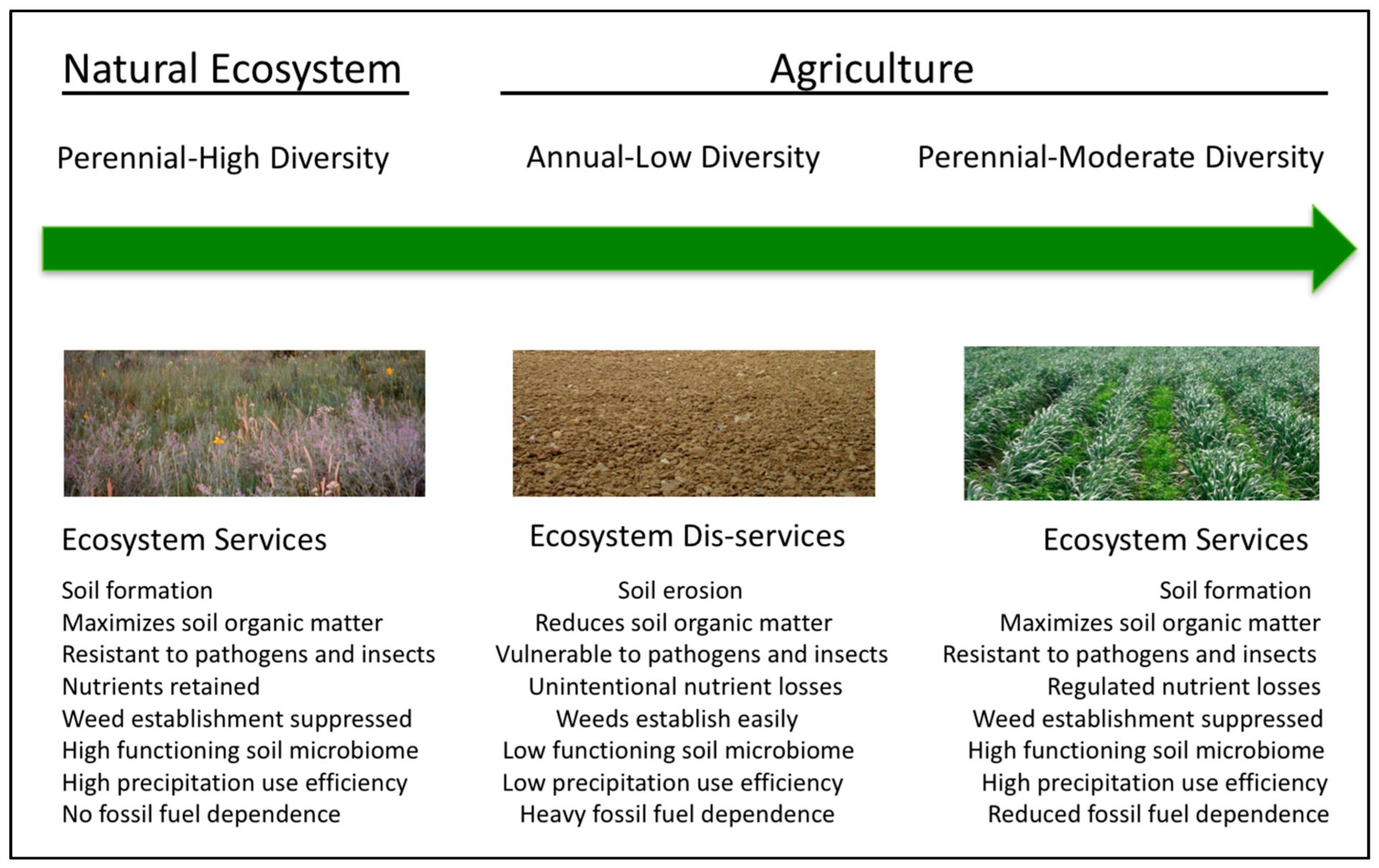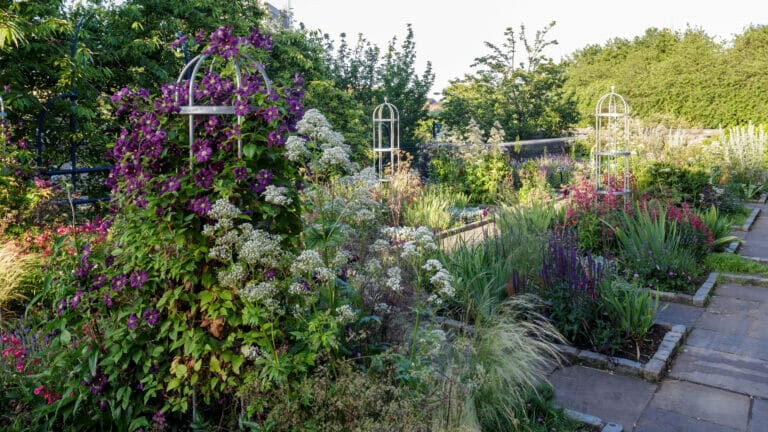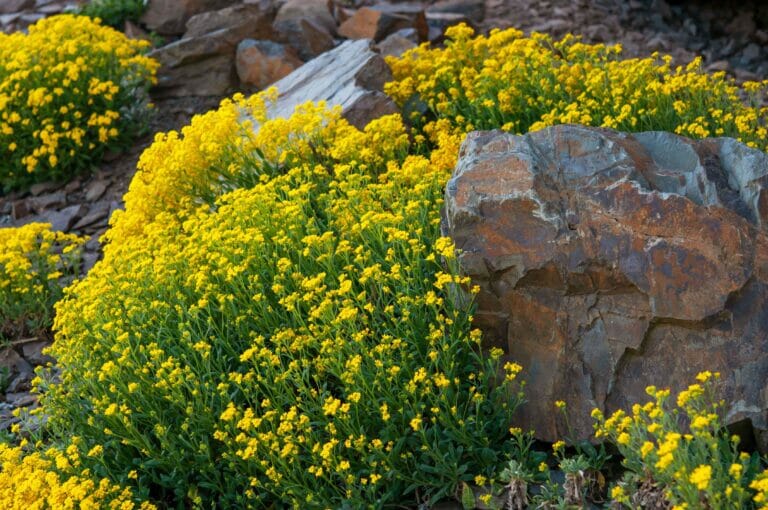
Perennials, what’s their role in ecosystem conservation? Let’s dive in and find out!
Perennials, those plants that come back year after year, have a crucial part to play in preserving our ecosystems. They are nature’s superheroes, with powers that help maintain a healthy balance in our environment. So, what exactly do they do?
Well, these resilient plants have deep roots that anchor them firmly in the ground, preventing soil erosion and holding water in times of drought. Additionally, perennials provide habitats and food sources for various animals, contributing to biodiversity. Let’s explore their incredible role in more detail.
Role of Perennials in Ecosystem Conservation?
Perennials play a crucial role in ecosystem conservation. They are long-lived plants that provide stability and support to ecosystems by preventing soil erosion, improving soil quality, and attracting pollinators. Perennials also contribute to biodiversity by providing habitats for various organisms.
Additionally, their deep root systems help in water conservation and nutrient cycling. By incorporating perennials into conservation practices, we can promote sustainable ecosystems and preserve the natural environment for future generations.
1. Creation of Habitat:
Perennials form the backbone of many ecosystems by creating essential habitats for a wide array of organisms. Their long lifespan and extensive root systems provide stability and structure to the environment, thus attracting and supporting diverse communities of plants, animals, and microorganisms.
These habitats serve as breeding grounds, resting places, and feeding areas for numerous species, contributing to their survival and promoting overall biodiversity. Whether it’s the lush understory in a forest or the colorful grassland meadows, perennials play a crucial role in fostering the rich tapestry of life within an ecosystem.
Perennials, with their ability to adapt to various environmental conditions, enable the establishment of intricate food chains and support complex ecological interactions. They provide shelter, nesting opportunities, and a source of food for birds, insects, and mammals.
For example, the flowers of perennials often attract pollinators like bees and butterflies, which in turn facilitate the reproduction of both plant and animal species. By creating diverse habitats and acting as ecological anchors, perennials contribute significantly to the conservation of ecosystems and the preservation of their delicate balance.
2. Soil Stabilization and Erosion Control:
One of the remarkable qualities of perennials is their ability to prevent soil erosion and promote soil stability. Their extensive root systems help bind the soil together, reducing the risk of erosion caused by wind or water.
This is particularly crucial in areas prone to erosion, such as slopes, riverbanks, and coastal regions. By anchoring the soil and preventing its displacement, perennials play a critical role in maintaining the health of ecosystems and protecting valuable agricultural land.
Furthermore, the deep roots of perennials act as conduits for water, enabling efficient water infiltration and preventing runoff. This helps to recharge groundwater reserves and maintain the water table, essential for the survival of both plant and animal life.
In addition, the organic matter produced by perennials as they shed leaves and stems contributes to the nutrient content of the soil, enhancing its fertility. These combined contributions of soil stabilization and enrichment support the long-term productivity and resilience of ecosystems.
3. Carbon Sequestration and Climate Regulation:
In an era of climate change, the role of perennials in carbon sequestration and climate regulation cannot be understated. Perennial plants store carbon in their tissues for prolonged periods, effectively removing carbon dioxide from the atmosphere.
As perennials have longer lifespans compared to annual plants, they have a greater capacity to sequester carbon over time. This carbon storage helps to mitigate climate change by reducing greenhouse gas emissions and lowering the concentration of atmospheric carbon dioxide.
Moreover, perennials contribute to the regulation of local climates through their ability to provide shade, regulate evaporation, and moderate temperature extremes. By creating microclimates, they offer protection to other plant species and provide a suitable environment for various organisms. This regulation of temperature and moisture levels within an ecosystem can mitigate the impacts of climate change and support the adaptation of species to changing environmental conditions.
4. Biodiversity Conservation:
Perennials are integral to biodiversity conservation efforts worldwide. The longevity and resilience of these plants make them reliable hosts for a vast range of organisms, contributing to the maintenance and enhancement of biodiversity. By fostering diverse habitats, perennials promote the coexistence of numerous plant and animal species, enabling the intricate web of life to flourish.
In addition, the genetic diversity within perennials themselves is crucial for ecosystem resilience. The genetic variability in populations of perennials allows them to adapt to changing environmental conditions, ensuring their survival in the face of disturbances like diseases, climate variability, and habitat degradation.
This genetic diversity also provides a valuable resource for the development of new varieties with desirable traits, fostering agricultural and horticultural advancements and promoting sustainable land management practices.
Overall, perennials play a central role in ecosystem conservation through their contribution to habitat creation, soil stabilization, climate regulation, and biodiversity conservation. Their long lifespan and resilience make them ideal candidates for sustainable land management, restoration projects, and efforts to combat climate change. Whether in forests, wetlands, grasslands, or gardens, perennials continue to hold immense ecological value and deserve our attention and preservation efforts.
Benefits of Incorporating Perennials in Ecosystem Conservation
1. Enhanced Biodiversity:
When perennials are included in ecosystem conservation efforts, they contribute to a higher level of biodiversity. By creating diverse habitats and providing resources for countless species, perennials help support a thriving and resilient ecosystem. This increased biodiversity not only promotes a healthier and more balanced environment but also enhances the stability and productivity of the ecosystem as a whole.
2. Soil Health and Nutrient Cycling:
Perennials are known to improve soil health through their extensive root systems and the organic matter they produce. Their deep roots penetrate the soil, promoting better water infiltration, preventing erosion, and enhancing nutrient cycling. As perennials shed leaves and stems, they contribute to the organic matter content of the soil, enriching it with valuable nutrients and supporting the growth of other plants.
3. Climate Change Mitigation:
By sequestering carbon dioxide from the atmosphere and regulating local climates, perennials play a vital role in mitigating climate change. Through their long lifespan and ability to store carbon in their tissues, perennials contribute significantly to the reduction of greenhouse gas emissions. In addition, their impact on local climate regulation helps to alleviate the effects of climate change on both natural and agricultural systems.
4. Water Conservation:
Perennials aid in water conservation by reducing runoff and enhancing water infiltration. Their extensive root systems act as natural water channels, increasing the absorption of water into the soil and reducing surface runoff. This allows for better water retention and recharging of groundwater reserves, supporting the overall water balance and availability in an ecosystem.
5. Ecosystem Resilience:
Incorporating perennials in ecosystem conservation efforts enhances the resilience of the ecosystem to environmental disturbances and changes. The longevity and adaptability of perennials allow them to withstand and recover from challenges such as droughts, wildfires, and habitat fragmentation. By preserving and utilizing perennials, we can create more robust and stable ecosystems that can better withstand the impacts of climate change and human activities.
6. Aesthetically Pleasing Landscapes:
Beyond their ecological benefits, perennials offer aesthetic value to landscapes. Their long-lasting blooms, diverse foliage, and vibrant colors make them popular choices for gardens, parks, and urban green spaces. Incorporating perennials in landscaping projects enhances an area’s visual appeal, supports wildlife habitat, and contributes to overall ecosystem health.
7. Sustainable Land Management:
Perennials are essential for sustainable land management practices, such as agroforestry, rotational grazing, and riparian zone restoration. Their deep roots and ability to withstand challenging conditions make them valuable tools for improving soil quality, preventing erosion, and promoting sustainable agricultural practices. By integrating perennials into land management strategies, we can minimize the environmental impact of human activities and foster long-term ecological sustainability.
Perennials and Ecosystem Conservation: Tips for Implementation
1. Select Native Perennials:
When incorporating perennials in ecosystem conservation efforts, prioritize native species that are well-adapted to local conditions. Native plant species are more resilient and require less maintenance, making them ideal for restoration projects and ecological landscaping. They also support native wildlife, as they have evolved together and provide the necessary resources for mutual survival.
2. Plan for Succession:
Consider the succession of perennials in your conservation plans. By selecting a combination of early, mid, and late-successional perennials, you can ensure year-round resources for wildlife and maintain the long-term stability of the ecosystem. The inclusion of various flowering periods and growth types will support a diverse array of pollinators and other beneficial organisms.
3. Create Wildlife-Friendly Spaces:
Design landscapes and conservation areas with wildlife in mind. Incorporate perennials that provide food sources, nesting materials, and shelter for different species. Include a variety of flowering plants, shrubs, and trees to attract a diverse range of pollinators, birds, and other wildlife. By creating these wildlife-friendly spaces, you can support the conservation of both plants and animals within an ecosystem.
4. Collaborate with Local Communities:
Engage and collaborate with local communities to promote the importance and benefits of perennials in ecosystem conservation. Educate and raise awareness about the role of perennials in supporting biodiversity, climate regulation, and sustainable land management practices. Encourage community involvement in planting and maintaining perennial gardens and restoration projects, fostering a sense of ownership and stewardship towards the environment.
5. Implement Ecologically-Sound Landscaping Practices:
When incorporating perennials into landscaping projects, adopt ecologically sound practices to minimize environmental impact. Use organic fertilizers, avoid chemical pesticides, and prioritize water conservation techniques. If possible, choose locally sourced perennial plants to reduce the carbon footprint associated with transportation.
6. Monitor and Evaluate:
Regularly monitor and evaluate the impact of perennials in ecosystem conservation efforts. Measure the success of restoration projects, observe changes in biodiversity, and track the overall health of the ecosystem over time. This information will help guide future conservation strategies and facilitate adaptive management practices.
7. Share Knowledge and Resources:
Share knowledge and resources about perennials and their role in ecosystem conservation. Collaborate with research institutions, community organizations, and governmental agencies to exchange information, best practices, and success stories. By sharing resources, we can collectively work towards more effective and widespread implementation of perennial-based conservation strategies.
In conclusion, perennials play a crucial role in ecosystem conservation, offering a multitude of benefits to habitats, biodiversity, soil health, climate regulation, and water conservation. By understanding and harnessing the power of perennials, we can enhance the sustainability and resilience of our natural environments. Through strategic implementation, education, and collaboration, we can work together to protect, restore, and conserve vital ecosystems around the world.
Frequently Asked Questions
In ecosystem conservation, perennials play a vital role in maintaining the balance and health of the environment. These long-lived plants help sustain biodiversity, enhance soil health, and provide resources for various organisms. Here are some frequently asked questions about the role of perennials in ecosystem conservation.
1. How do perennials contribute to biodiversity conservation?
Perennials are important contributors to biodiversity conservation in ecosystems. Their long lifespan allows them to establish stable habitats and provide shelter and food for many organisms. By hosting diverse populations of insects, birds, and small mammals, perennials foster intricate ecological relationships and promote overall ecosystem health. Their presence supports the survival and reproduction of various species, ultimately helping to maintain a balanced ecosystem.
Moreover, perennials often have deep root systems that help prevent soil erosion and promote nutrient cycling. This further enhances the stability and productivity of the ecosystem, supporting a wider range of plant and animal life. By preserving and planting perennials, we can actively contribute to the conservation of biodiversity and the sustainability of ecosystems.
2. How do perennials improve soil health?
Perennials play a crucial role in improving soil health due to their long lifespan and extensive root systems. Unlike annual plants, perennials continuously accumulate organic matter, such as dead leaves and fallen branches, on the forest floor. As this organic matter decomposes, it enriches the soil, making it more fertile and nutrient-rich.
Furthermore, the deep root systems of perennials help prevent soil erosion, as they anchor the soil and increase water infiltration. By holding the soil in place, perennials mitigate the loss of topsoil and reduce the risk of landslides during heavy rain events. Their roots also facilitate the movement of water and nutrients through the soil, supporting the growth of other plants and enhancing overall soil health.
3. How do perennials contribute to pollinator conservation?
Perennials are vital for the conservation of pollinators such as bees, butterflies, and birds. Many perennials possess flowers that are specifically adapted to attract these pollinators, providing them with a crucial food source in the form of nectar and pollen. By hosting a variety of perennial flowers, we create habitats that support the diverse needs of pollinators throughout their lifecycles.
Not only do perennials offer sustenance to pollinators, but they also provide nesting sites and shelter. Some perennials, like milkweed, are essential for the survival of specific pollinator species. Monarch butterflies, for example, rely on milkweed plants for egg-laying and larval development. By incorporating perennials into our landscapes, we can create pollinator-friendly environments, helping to safeguard these important and threatened species.
4. How do perennials contribute to carbon sequestration?
Perennials are powerful allies in the fight against climate change due to their ability to sequester carbon dioxide, a greenhouse gas responsible for global warming. Through a process called photosynthesis, perennials absorb carbon dioxide from the atmosphere and store it as carbon in their leaves, stems, and roots. As perennials have a longer lifespan than annual plants, they have a greater capacity to accumulate carbon over time.
Besides storing carbon, perennials can also reduce carbon emissions by preventing soil erosion and degradation. Healthy soils, preserved by the presence of perennials, retain more carbon and release fewer greenhouse gases into the atmosphere. By promoting the growth and conservation of perennials, we contribute to the reduction of carbon dioxide levels and the mitigation of climate change.
5. How can we incorporate perennials into our landscape to support ecosystem conservation?
Integrating perennials into our landscape can be a simple yet effective way to support ecosystem conservation. Start by identifying native perennial plant species that are well-suited to your region and soil conditions. Native perennials are adapted to the local environment and typically require less maintenance and irrigation.
Consider planting a diverse array of perennials to provide resources for different organisms throughout the year. By including flowering perennials, you can attract pollinators and add visual appeal to your landscape. Additionally, leaving some areas in your garden or yard undisturbed allows existing perennials to thrive while providing essential habitats for various wildlife species. By consciously incorporating perennials into our landscapes, we can actively contribute to the conservation of ecosystems and the protection of our natural heritage.
Perennials play an important role in conserving ecosystems. They are plants that live for multiple years and can keep the soil healthy. Perennials have deep roots that prevent erosion and help retain water in the ground. They provide habitats for animals and support biodiversity.
These plants also capture carbon dioxide from the atmosphere, reducing the effects of climate change. By planting perennials, we can contribute to conserving our environment and protecting the planet.
In addition to their environmental benefits, perennials offer practical advantages too. They require less maintenance compared to annual plants because they do not need to be replanted every year. Perennials can survive in different weather conditions, making them resilient and adaptable. They also come in a variety of colors, shapes, and sizes, making our gardens more beautiful. So, consider adding perennials to your garden and help make a positive impact on the environment.



